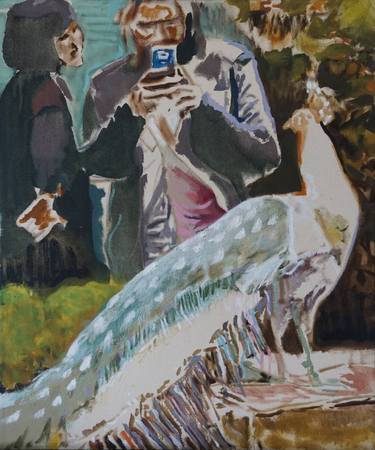Discovering Iconic Artists and Their Influences on Figurative Oil Painting
Discovering Iconic Artists and Their Influences on Figurative Oil Painting
Blog Article
Grasping the Art of Figurative Oil Painting: Important Tips and Techniques for Aspiring Artists
Figurative oil paint stands for an intricate crossway of method and interpretation, demanding a comprehensive comprehension of human anatomy, make-up, and shade theory. Aspiring musicians have to not just understand the nuances of form and activity yet likewise think about how compositional strategies can amplify psychological vibration. Additionally, an exploration of shade harmony and texture strategies can substantially improve the aesthetic effect of their work. As musicians development in their journey, the concern occurs: just how can one cultivate a distinct style while understanding these foundational elements? The succeeding expedition of these crucial elements promises to brighten the path ahead.

Comprehending Human Makeup
Recognizing human anatomy is fundamental for any type of musician striving to understand metaphorical oil paint. A comprehensive grasp of the human form allows artists to produce realistic depictions that reverberate with customers. Expertise of physiological frameworks, such as bones, muscular tissues, and joints, gives essential understanding right into just how the body actions and postures.
Musicians must acquaint themselves with the proportions of the human figure, including the relationship between various body components and exactly how these proportions vary across sexes and ages. This understanding enables precise scaling and perspective in their work. In addition, recognizing the underlying musculature boosts the capability to portray movement and tension in a number, resulting in an extra engaging and vibrant composition.
Examining makeup additionally helps in determining subtle nuances in pose and expression, which are important for sharing emotion and narrative within a paint. Resources such as physiological textbooks, life drawing sessions, and on the internet tutorials can be invaluable tools for musicians seeking to grow their anatomical expertise. Eventually, mastering human makeup not only boosts technological ability however additionally improves an artist's creative vision, allowing them to bring their metaphorical oil paints to life with authenticity and depth.
Significance of Structure

Trick principles of make-up include equilibrium, unity, and centerpieces. Attaining equilibrium makes sure that no single component overwhelms the others, while unity produces a sense of harmony throughout the piece. Focal points draw interest to considerable aspects of the art work, permitting visitors to engage with the story or theme more deeply.
Additionally, the use of leading lines and the guideline of thirds can substantially improve make-up. Leading lines naturally guide the viewer's look with the paint, while the policy of thirds gives a structure for putting crucial elements in a visually appealing manner. By grasping structure, aspiring musicians can raise their figurative oil paints, changing them right into compelling aesthetic stories that reverberate with their target market.
Learning Shade Concept
Shade theory acts as an essential aspect of figurative oil paint that complements the concepts of make-up. Comprehending the shade wheel, which consists of primary, second, and tertiary colors, is necessary for creating unified combinations and reliable visual stories.
Trick concepts such as saturation, value, and shade play a crucial role in figuring out the mood and effect of a painting. Musicians need to check out awesome and warm colors to stimulate particular feelings; cozy colors commonly convey power and enthusiasm, while trendy shades can impart peace and peace.
The partnership in between complementary colors-- those opposite each other on the color wheel-- can develop striking contrasts and dynamic make-ups. When compared, these colors enhance each various other's vibrancy, drawing the visitor's eye and including depth to the artwork.
Furthermore, understanding comparable colors enables musicians to attain a sense of unity and coherence. By selecting shades that are nearby on the wheel, one can keep a balanced environment throughout the item.
Ultimately, grasping shade theory gears up aspiring musicians with the tools essential to control color intentionally, improving their capability to communicate emotion and narrative through metaphorical oil paint. figurative oil painting.
Techniques for Appearance
A range of methods can successfully produce appearance in metaphorical oil painting, adding depth and measurement to the art work. One fundamental technique is using impasto, where thick layers of paint are applied to the canvas, enabling a three-dimensional high quality. This technique improves light communication, developing dynamic visual passion.
One more method is scumbling, which involves applying a thin layer of lighter paint over a dried out darker layer. This method enables the underlying color to go reveal through, resulting in a soft, distinctive effect that can stimulate a sense of ambience or age. Dry cleaning is likewise vital; utilizing a dry brush with minimal paint, musicians can develop fragile textures and fine lines, excellent for capturing the nuances of skin or fabric.
Additionally, combination knives can be utilized to use or scrape paint, generating special patterns and structures. Experimenting with various tools and products, such as sponges or dustcloths, can better enrich the textural quality of a paint. Eventually, grasping these strategies calls for practice and try this site trial and error, enabling musicians to find the diverse tactile qualities that can boost their figurative works.
Establishing Your One-of-a-kind Style
A musician's distinct design is usually the culmination of individual experiences, affects, and techniques honed over time. Establishing this originality in figurative oil painting calls for a mindful initiative to check out both your inner self and the more comprehensive artistic landscape. Begin by assessing the themes and subjects that reverberate with you emotionally; your enthusiasm will certainly instill authenticity into your work.
Study different styles and movements, yet instead than mimicing, remove aspects that speak with you - figurative oil painting. Trying out various strategies, shade palettes, and structures, allowing on your own the liberty to play without the stress of perfection. Maintain a sketchbook or journal to record your ideas, concepts, and artistic progress; this will certainly act as a valuable source for determining repeating choices and themes
Seek constructive feedback from peers or coaches, as they can offer understandings that illuminate aspects of your job you might forget. Be person with on your own; the trip of developing an one-of-a-kind style is recurring, evolving with every canvas and each brushstroke you come across.

Final Thought
Grasping figurative oil paint requires a comprehensive grasp of human composition, composition, and shade concept. Embracing these foundational concepts will substantially profit aiming artists on their innovative journey.
Figurative oil painting stands for an intricate crossway of method and interpretation, demanding a detailed comprehension of human composition, composition, and shade theory. An expedition of shade consistency and texture techniques can substantially enhance the aesthetic influence of their job. By understanding structure, aspiring musicians can raise their metaphorical oil paints, changing them into compelling visual tales that reverberate with their audience.
Experiment with different techniques, shade palettes, and make-ups, enabling on your own the freedom to play without the pressure of perfection.Grasping metaphorical oil see this paint requires a thorough grasp of human makeup, composition, and color theory.
Report this page